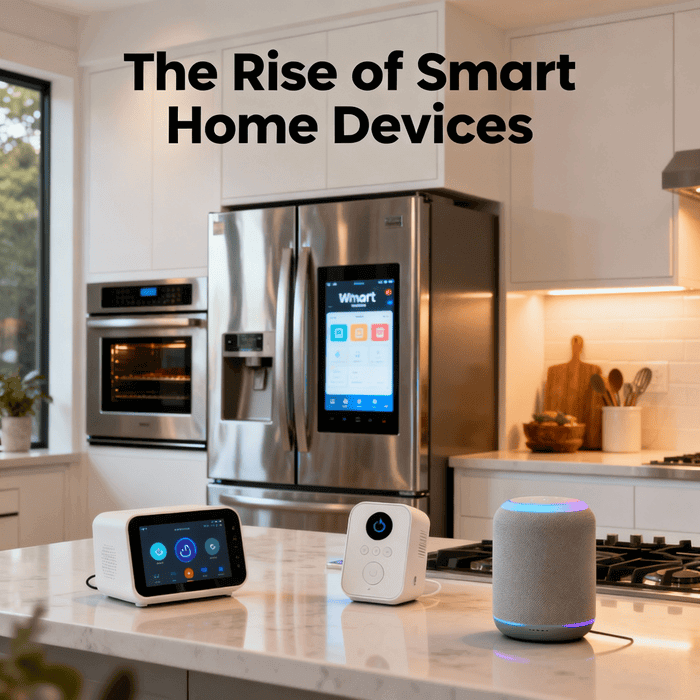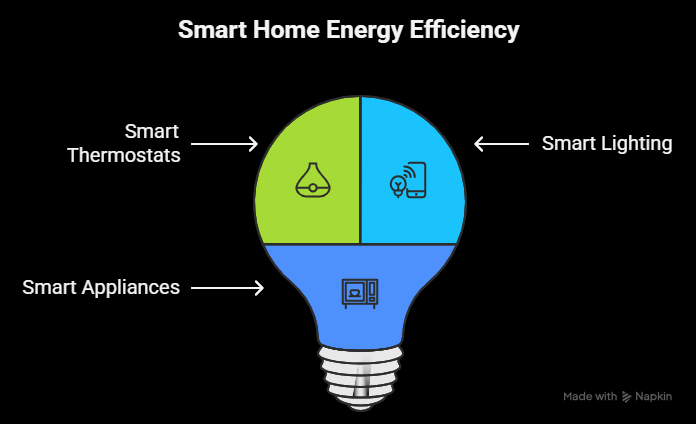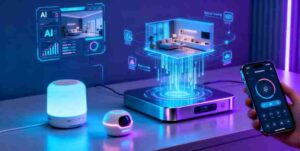Table of Contents
The Rise of Smart Home Devices: How Technology Is Transforming Modern Living
Smart home devices have rapidly transformed how people interact with their living spaces. From refrigerators that monitor groceries to thermostats that learn your preferences, smart technologies are redefining the concept of comfort, convenience, and energy efficiency. Among these innovations, smart fridges stand out as one of the most remarkable examples of advanced home automation in action. A lot of smart home devices actually run on Android.
This article explores the world of modern smart home devices—how they work, what kind of technology powers them, and how households are reaping the rewards. We’ll also examine the importance of repair and maintenance for these devices, including specialized services like appliance repair Decatur, to keep your smart home running smoothly.

The Evolution of Smart Home Devices
The idea of an automated home began as science fiction but quickly became reality. In the early 2000s, the rise of Wi-Fi and the Internet of Things (IoT) made it possible for everyday appliances to connect to the internet and communicate with users.
Smart home devices can now be found in almost every corner of the home, including:
- Smart refrigerators that track food inventory and suggest recipes.
- Smart thermostats that reduce energy use by learning your habits.
- Intelligent lighting systems that adjust intensity according to natural light or motion.
- Smart speakers that control other appliances through voice commands.
- Robotic vacuums that autonomously clean and map living spaces.
As technology continues to evolve, these systems are becoming more affordable, accessible, and integrated.
Read More: The Complete Guide to Smart Refrigerators: How AI is Revolutionizing Your Kitchen in 2025
What Makes a Device “Smart”?
A device is considered smart if it can collect data, communicate with other devices or systems, and make decisions based on that data. This capability is made possible through a combination of hardware, software, and connectivity.
Key components of smart devices include:
- Sensors: These capture data such as temperature, humidity, motion, and light.
- Microprocessors: Small, powerful chips that analyze data and execute tasks.
- Connectivity modules: Wi-Fi, Bluetooth, or Zigbee chips allowing communication with apps or cloud systems.
- Actuators: Mechanisms that convert electrical signals into physical actions (e.g., turning a compressor on or adjusting a thermostat).
- User interfaces: Touchscreens, companion apps, or voice commands that let users control and monitor devices easily.
This intricate ecosystem transforms passive appliances into interactive systems—ones that respond intelligently to human behaviour.
Read More: Top 5 New Features of Android 16 in 2025: Complete Guide
Spotlight on Smart Fridges: The Centerpiece of a Connected Kitchen
Among all smart home devices, the smart refrigerator exemplifies the peak of modern appliance innovation. More than just a place to store food, it has become an information hub, entertainment center, and even a personal assistant in some homes.
What a Smart Fridge Can Do
Smart fridges integrate multiple technologies to improve your daily life. Common features include:
- Inventory management: Built-in cameras monitor fridge contents and send updates to your smartphone when you’re shopping.
- Expiration tracking: The fridge can remind you when certain foods are expiring.
- Touchscreen displays: These often allow you to create shopping lists, leave digital notes, or mirror your smart TV’s display.
- Voice assistants: Integrated with Alexa or Google Assistant, you can ask about recipes, add groceries to your cart, or control other devices.
- Energy optimization: Sensors and algorithms help the fridge adjust cooling levels for maximum efficiency.
- Remote monitoring: Users can adjust temperature settings or check inventory from anywhere through a connected app.
The Hardware Behind the Magic
Smart fridges use a sophisticated combination of hardware components, including:
- Cameras: High-resolution internal cameras scan shelves and take pictures periodically to track contents.
- Temperature and humidity sensors: Maintain optimal food preservation conditions.
- Microcontrollers and PCI boards: Process user inputs and system data in real time.
- Connectivity chips: Enable the fridge to communicate with your home network and cloud services.
- Touch displays: Typically powered by Android-based interfaces for intuitive navigation.
Together, these components form the backbone of a device that’s as much a computer as it is an appliance.
How Technology Integrates Into Everyday Appliances
The same technological sophistication that powers smart fridges extends across many smart devices. For instance:
- Smart ovens use Wi-Fi connections and thermal sensors to control cooking times and temperatures automatically.
- Dishwashers equipped with AI can detect load weight and adjust water use accordingly.
- Washing machines connect to mobile apps, allowing you to start cycles or receive alerts when laundry is done.
Each of these smart devices relies on IoT networks, data analytics, and cloud servers to synchronize functions. Over time, they “learn” your patterns, making operations smoother and more efficient.
Benefits for Modern Households
The adoption of smart home devices offers profound advantages that extend beyond convenience.

Energy Efficiency

Smart thermostats, lighting, and appliances are designed to minimize energy consumption. For example, a smart fridge can reduce energy waste by adjusting cooling only when necessary or during off-peak hours.
Cost Savings
Though initial investments can be high, smart devices lower long-term costs through energy savings and predictive maintenance. Predictive diagnostics notify users of potential issues before costly breakdowns occur.
Enhanced Convenience
Smart kitchens simplify meal prep, while voice-controlled assistants allow you to multitask effortlessly. Configurable lighting and temperature schedules help optimize your home environment automatically.
Improved Food Management
Smart fridges can reduce food waste by reminding you of expiration dates or helping plan meals based on what’s already in stock. This not only saves money but also reduces the household’s environmental footprint.
Security and Peace of Mind
With integrated security systems, users can monitor doors, cameras, and even smoke alarms remotely. Smart locking systems enhance protection and convenience simultaneously.
The Role of Artificial Intelligence in Smart Appliances
Modern smart devices are driven by AI algorithms that analyze patterns and optimize performance automatically.
- Machine learning enables appliances to recognize usage trends, such as when you open the fridge most often.
- Predictive analytics anticipate when maintenance is required, preventing unexpected failures.
- Computer vision is used in smart fridges to identify items and manage inventory.
- Voice recognition AI refines interactions, allowing for seamless conversation-like control.
Through AI, appliances not only follow commands but anticipate them—turning smart homes into responsive ecosystems.
Maintenance, Repair, and the Future of Smart Appliances
As smart home devices become more complex, proper maintenance and repair become critical. Unlike traditional appliances, smart devices require both hardware and software support. Regular software updates improve security and add new capabilities, while hardware components like sensors and processors may occasionally need servicing.
For homeowners dealing with technical issues, professional repair services ensure longevity. For instance, there are specialists are trained to diagnose not just mechanical faults but also network and firmware problems in smart systems. This expertise prevents minor glitches from developing into major disruptions.
Hardware Challenges Facing Smart Appliance Development
While smart appliances promise convenience, they also face engineering and reliability challenges:
- Hardware longevity: Continuous connectivity and frequent data transmission can strain processors and memory units.
- Software interoperability: With multiple brands using different ecosystems, integration remains a challenge.
- Data security: As devices collect personal data, manufacturers must prioritize encryption and network safety.
- Repairability: Some smart appliances have proprietary hardware, limiting third-party repairability.
Overcoming these issues will determine how smoothly the transition toward fully connected homes progresses.
Smart Homes and Sustainability
Another driving force behind smart device adoption is sustainability. Connected appliances allow for more responsible energy consumption. For example:
- Smart washing machines optimize water use per load.
- Smart thermostats help reduce electricity usage.
- Energy dashboards display real-time data on power consumption, promoting eco-friendly behaviors.
Government incentives and green energy programs are accelerating these trends, encouraging households to upgrade to smart systems that align with global environmental goals.
Vivo X300 Pro Telephoto Camera: 200MP Zoom With Stunning Moon Shot Sample
The Future: Fully Integrated Smart Living
The long-term goal is complete home integration, where all devices communicate through a unified AI hub. Imagine your smart fridge coordinating with your oven to preheat based on your evening meal plan, while your lighting adjusts automatically when dinner is ready.
Future innovations will likely involve:
- Interoperable ecosystems: Allowing devices from different brands to operate seamlessly.
- Greater automation: Predictive scenarios based on user mood and health metrics.
- Integration with renewable energy systems: Synchronizing with solar panels or home battery storage.
- Personalized nutrition tracking: Using AI to offer health advice based on fridge contents.
The smart home of tomorrow will not only respond but adapt—learning from occupants to create personalized environments that enhance well-being and sustainability.
Conclusion
Smart home devices, and smart fridges in particular, symbolize how deeply technology is embedding itself into daily life. They embody convenience, efficiency, and intelligence—turning homes into responsive spaces that cater to individual needs. Through advanced hardware, AI integration, and connectivity, these devices redefine what it means to live “smart.”
As innovation continues, the line between technology and domestic life will blur even further. Whether through enhanced energy management, digital convenience, or proactive maintenance, smart home devices are shaping a future where living smarter isn’t just a luxury—it’s an expectation.
Read More: Machine Learning in Edge Computing: Smarter Devices, Less Cloud Dependency







